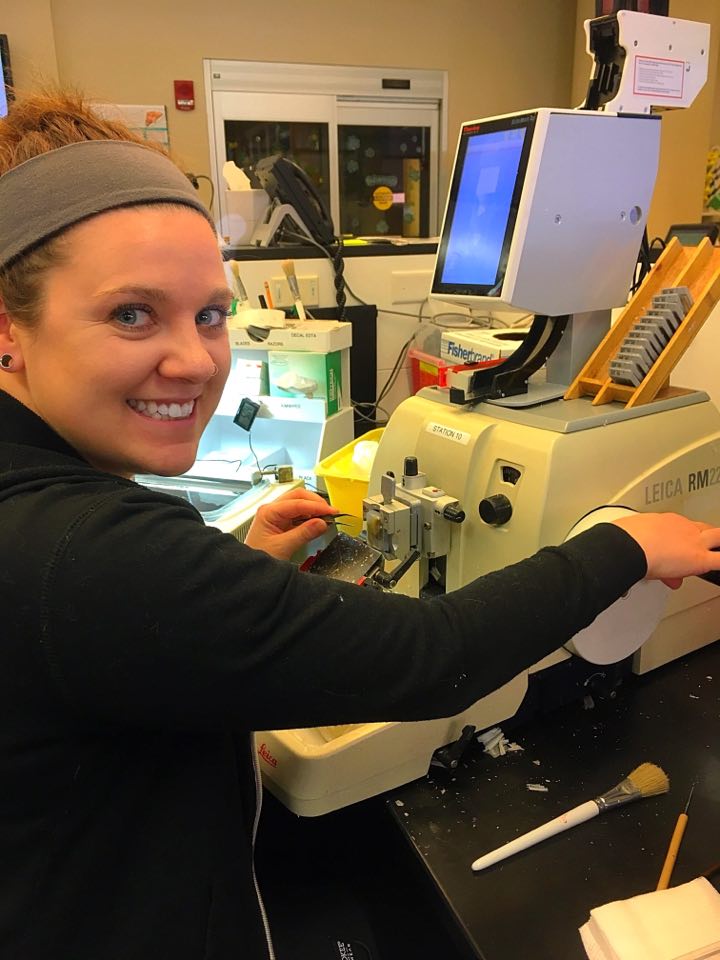The Hidden Ninjas of Pathology
There’s a group of behind-the-scenes heroes in the pathology field… heroes who go unseen. Unknown to the outside world, their work plays a fundamental role in patient diagnoses.
These people are the histotechnicians and histotechnologists.
Spotlight on a Histotechnician
In honor of Histotechnology Professionals Day and International Women’s Day (March 8), we’d like to take a moment to share a story of a modern day histo-ninja.
 Autumn Kossuth is a histotechnician in a large reference lab in Pittsburgh, Pennsylvania. We recently talked to her about her career and how she found the path to becoming a histotechnology professional.
Autumn Kossuth is a histotechnician in a large reference lab in Pittsburgh, Pennsylvania. We recently talked to her about her career and how she found the path to becoming a histotechnology professional.
The first thing that became immediately clear at the onset of our conversation is that Autumn loves what she does! She was excited to talk about it and share her story…
Initially, like many people outside of the field, she didn’t know much about histology. In fact, it was seeing a multitude of job listings for histologists that prompted her to find out more about it… and she was thrilled with what she discovered.
Histotechnicians and Histotechnologists
A little background for those of you who aren’t in the field… in a histology lab, there are histotechnicians and histotechnologists. Each has different minimum educational requirements as well as a different ASCP (American Society for Clinical Pathology) exam. And license requirements differ from state to state.
Hidden behind the curtain, the histotechnicians and histotechnologists perform a sort of magic. They receive fresh tissue from the pathologist, and through a series of processes, turn it into a microscope slide that shows the pathologist whatever it is within the tissue that they need to see.
The lab that Autumn works in is a reference lab. It holds a broad catalog of immunohistochemical stains, and each stain highlights a different structure within the tissue. Working in a reference lab means that they do a lot of special stains on a wide variety of tissue types. Many of the samples they prepare are from labs outside of their local hospital.
The first slide returned to the pathologist is typically stained with hematoxylin and eosin (H&E) stain. The pathologist may ask for a specific stain after viewing the initial slide in order to help them diagnose any disease or medical condition. The stain used varies depending on their observations.
The daily routine in the histology lab is far from mundane. Autumn says it’s never the same. “Every tissue cuts differently. Every tissue behaves differently.”
Words of Wisdom
Autumn’s advice to anyone considering becoming a histology professional: “Go for it! It’s a fun field. It requires you to have knowledge, but it also requires you to have a technical skill. It’s nice to have a job that requires both aspects.”
When asked the best thing about being a histotechnician, without hesitation Autumn replied, “Our work is directly impacting the patient, but the patient has no idea we exist. We’re like ninjas… histo-ninjas.”
The Future of Histology
Every year on March 10, The National Society for Histotechnology (NSH) celebrates Histotechnology Professionals Day. Its purpose is to bring awareness of the profession to the public, prospective students, and other medical and allied health professionals.
Like many other fields, histology is facing a staffing shortage in the coming years as baby boomers retire and there are fewer people entering the field. So spread the word and share this information with people you know who are looking at career options or considering new careers in the medical or laboratory fields. We have word from the inside that it’s an awesome career!
At PathSUPPLY, we’re here to fulfill the supply needs of histo-ninjas and all pathology and laboratory professionals. Check out our website or give us a call at 1-800-631-3556.
PathSUPPLY… helping those who help patients.
